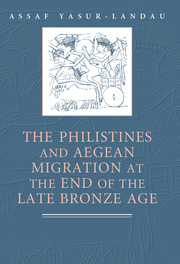Book contents
- Frontmatter
- Contents
- Acknowledgments
- INTRODUCTION
- 1 THE ARCHAEOLOGICAL IDENTIFICATION OF MIGRATION AND OTHER RANGES OF INTERREGIONAL INTERACTIONS
- 2 SETTING THE SCENE: THE MYCENAEAN PALATIAL CULTURE AND THE OUTSIDE WORLD
- 3 THE TWELFTH-CENTURY-BCE AEGEAN: POLITICAL AND SOCIAL BACKGROUND
- 4 PRECONDITIONS FOR MIGRATION
- 5 ALONG THE ROUTES
- 6 STRICTLY BUSINESS? THE SOUTHERN LEVANT AND THE AEGEAN IN THE THIRTEENTH TO THE EARLY TWELFTH CENTURY BCE
- 7 THE MATERIAL CULTURE CHANGE IN TWELFTH-CENTURY PHILISTIA
- 8 THE PHILISTINE SOCIETY AND THE SETTLEMENT PROCESS
- 9 A SHORT HISTORY OF THE AEGEAN IMMIGRATION TO THE LEVANT
- Bibliography
- Index
8 - THE PHILISTINE SOCIETY AND THE SETTLEMENT PROCESS
Published online by Cambridge University Press: 04 August 2010
- Frontmatter
- Contents
- Acknowledgments
- INTRODUCTION
- 1 THE ARCHAEOLOGICAL IDENTIFICATION OF MIGRATION AND OTHER RANGES OF INTERREGIONAL INTERACTIONS
- 2 SETTING THE SCENE: THE MYCENAEAN PALATIAL CULTURE AND THE OUTSIDE WORLD
- 3 THE TWELFTH-CENTURY-BCE AEGEAN: POLITICAL AND SOCIAL BACKGROUND
- 4 PRECONDITIONS FOR MIGRATION
- 5 ALONG THE ROUTES
- 6 STRICTLY BUSINESS? THE SOUTHERN LEVANT AND THE AEGEAN IN THE THIRTEENTH TO THE EARLY TWELFTH CENTURY BCE
- 7 THE MATERIAL CULTURE CHANGE IN TWELFTH-CENTURY PHILISTIA
- 8 THE PHILISTINE SOCIETY AND THE SETTLEMENT PROCESS
- 9 A SHORT HISTORY OF THE AEGEAN IMMIGRATION TO THE LEVANT
- Bibliography
- Index
Summary
The archaeological evidence supporting an Aegean migration to the southern Levant in the twelfth century enables us to address the conflicting views (see Chapter 7) concerning the nature of this migration, from the origin and number of migrants to their social and political structure, and the absolute chronology of the settlement. The different circumstances of settlement at each site demonstrated in Chapter 7 are a strong indication that, rather than a simple, unified event of migration and violent conquest, suggested by Ramses III's Year 8 inscription and the Ugarit letters, the Aegean settlement should be seen as complex, co-occurring migration processes, with great variability between the different sites in Philistia. Hence, rather than reconstructing the settlement process from preexisting historical dogma, this chapter attempts to answer questions relating to the migration by first examining the society created by the earliest migrants, from general settlement patterns to economy, and to the makeup of the Philistine population in the twelfth century bce. This reconstruction lays the foundations needed to address the thorny questions of the sequence of events of the settlement and its chronology: was the settlement process a long or short one? Was it contemporaneous in all Philistia or was it gradual? Did it take place during the Egyptian domination of Canaan? Was it perhaps controlled by the Egyptians? Or did it mark the end of Egyptian domination?
- Type
- Chapter
- Information
- Publisher: Cambridge University PressPrint publication year: 2010



